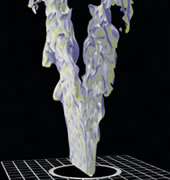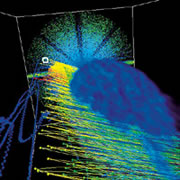
Advanced Computing, page two

Using 3-D, time-dependent software, a team in the Lab's Center for Computational Sciences and Engineering has created the first detailed simulations of turbulent methane combustion. Flame modeling has applications for devices including power generators, heating systems, water heaters, stoves, and even clothes driers.
Advanced computing — a third mode of science, complementing both theory and experiment — has become indispensable to a wide range of disciplines. A few examples among many:

Visualizing a cloud of electrons in a beam enables engineers to fine-tune high-energy particle accelerators for optimum performance.
Molecules known as carotenoids are an organism’s first line of defense against damage by free radicals. In humans, carotenoids protect the eyes from chemical reactions triggered by bright light. Plants are equally at risk from light that’s too bright; during photosynthesis, carotenoids quench chlorophyll states that would otherwise generate low-energy oxygen molecules, which could damage or even kill the plant. Carotenoids play other important roles in regulating photosynthesis as well.
Exactly how they do it is a mystery. Carotenoid electronic structure is so complex it can’t be studied by optical spectroscopy, but computing the excited states is a daunting task. One of the first three INCITE Awards from DOE’s Office of Science went to William Lester, Jr., of the Chemical Sciences Division, and Graham Fleming, then director of the Physical Biosciences Division — a grant of a million hours of NERSC supercomputer time to study carotenoids in photosynthesis using a statistical method called Quantum Monte Carlo simulation.
These methods require enormous computing power — 80,000 NERSC hours for each electronic state, for each kind of carotenoid — but can produce results as accurate as those of an experiment. (No such experiments are possible, outside the computer.) Lester and Fleming expect the NERSC studies to clarify the carotenoid-chlorophyll interaction in photosynthesis, bringing the day closer when nature’s clean, exquisitely efficient method of converting light to chemical energy can be reproduced synthetically.
A computing problem that could lead to more efficient turbines, furnaces, and incinerators is modeling turbulence in flames. The problem itself demands advanced visualization software, the kind that John Bell and Phillip Colella of the Computational Research Division delight in devising.